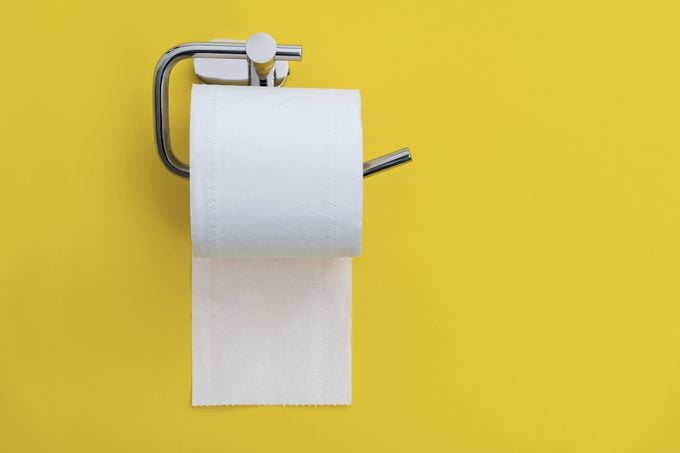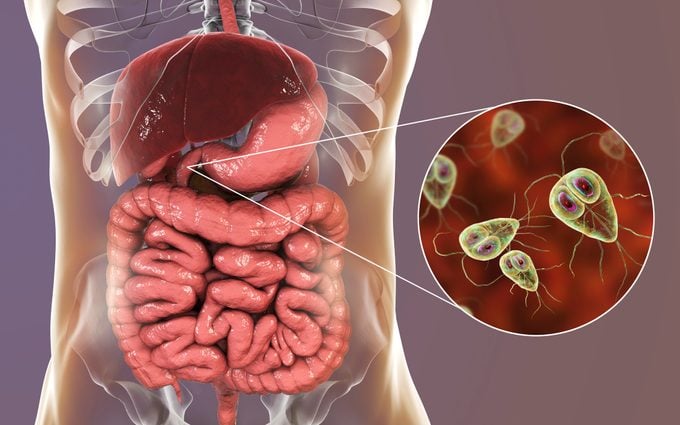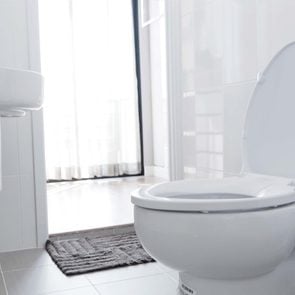Why Do I Have Yellow Poop? 9 Most Common Reasons
Updated: Jul. 13, 2022
Your poop could be yellow for a number of reasons. It could be something you ate, a medication you're taking, or something else going on in your digestive tract. Here's when to get it checked out.

Generally, “normal” poop should be brown. When you eat food, it eventually turns that color by the time it exits the body in the form of stool, according to Baltimore colon and rectal surgeon Jeffery Nelson, MD, the surgical director at The Center for Inflammatory Bowel and Colorectal Diseases at Mercy Hospital in Baltimore.
Why? As food makes its way down the digestive tract, it gets stained by bile, which constantly drains into the gut. Bile, which breaks down fats, is made by the liver, stored in the gallbladder and is released through bile ducts as needed during digestion.
But an off-color poop now and then isn’t necessarily worrisome, experts say. Most shades along the spectrum of yellow through green through brown are within the range of “normal,” depending on what you’ve been eating, what medications you’ve been taking, and even if you’re feeling psychological stress, says family practice physician, Christine Traxler, MD, who practices at Invigor Medical in Le Sueur, Minnesota.
According to the Cleveland Clinic, off-color stool is probably because of something you ate— though it may also be a sign of underlying health issues.
9 Health Issues Millennials (and Their Parents) Need to Stop Ignoring
That can mean anything from a minor “disagreement” between you and your belly to something more serious such as infection, irritable bowel syndrome, parasites, gallstones, inflammatory bowel disease, and other diseases of the digestive tract, says Harry Thomas, MD, a gastroenterologist in Austin, Texas.
So here are the most common reasons your stool might be yellow.
You’re a baby
Mustard-colored stool is actually normal for newborns, according to Dr. Traxler. If you’re not nursing, your baby’s stool should turn to brown after the first couple of days.
For breastfed babies, yellow stool is normal until formula or solid food is introduced.
It’s something you ate
Assuming you’re not a baby, if you notice yellow poop, Dr. Traxler suggests the first thing to do is consider what you’ve eaten in the last day or so. Stool may appear yellow because you’ve had a large quantity of carrots, sweet potatoes, or other beta-carotene-rich produce. Or perhaps you enjoyed a meal rich in turmeric. Even artificially colored yellow foods can turn your stool yellow. In each case, stool takes on the color yellow simply because the pigment is not easily digested.
Your stool might also be yellow if you ate something that disagreed with you, such as
- if you’re lactose intolerant but just helped yourself to a scoop of ice cream. (We’ll discuss that below in relation to food intolerance.)
- if you’ve been under unusual stress, which can speed up GI transit time so that your stool doesn’t have time to develop its normal brown color. However, in that case, your yellow stool will likely be softer than normal, if not liquid (diarrhea).
- if you have irritable bowel syndrome, and you ate one of these 10 foods likely to make your symptoms worse. If you think you might have irritable bowel syndrome (IBS), here are the symptoms and conditions you’ll want to bring up with your doctor.
Slightly more worrisome is if you routinely find your stool is yellow specifically after you’ve eaten fatty, oily, or greasy food. That may be a sign of a problem with the bile from your liver, which often involves other symptoms, as discussed below.
15 Signs Your Diet Is Making You Sick
You picked up an infection
When food moves faster than usual through your gastrointestinal (GI) tract, it’s more likely to come out on the other end looking yellow (or even greenish or green, although there are many reasons that you might pass green poop).
In addition to stress, another cause of food moving rapidly through the GI tract is foodborne infection, according to Kumar Desai, MD, gastroenterologist, hepatologist, and pancreaticobiliary specialist in Thousand Oaks, California.
Foodborne infections are caused by a variety of bacteria, viruses, and parasites and are transmitted by ingesting contaminated food or water or, in some cases, through direct contact with another person or animal that has been infected. Other symptoms of foodborne infection may include abdominal discomfort/cramping, diarrhea, and fatigue. In addition, you may see undigested food in your stool, Dr. Traxler says.

You picked up the parasite, Giardia
Although it’s not normal, it’s not exactly uncommon either, to pick up an intestinal parasite. An intestinal parasite is an actual organism living in your intestinal tract. Many intestinal parasites are transmitted through food and water, although some can be shared by person-to-person contact.
One of the most common intestinal parasites in the United States, Giardia, can cause the stool to appear yellow—and have a soft or liquid consistency—because it causes the food to move quickly through the GI tract. Giardia, which is most commonly transmitted through ingesting contaminated water, may also cause symptoms like cramps, diarrhea, nausea, and vomiting. In addition, when the diagnosis is giardiasis (the infection caused by Giardia), you’ll typically pass bright yellow stool.
Why Is My Poop Light Tan? Here’s What Causes Pale or Clay-Colored Stool
Food intolerance
Any sort of food intolerance, including lactose intolerance, can irritate the GI tract, causing food to move too quickly to pick up the normal brown color. (Here’s the difference between a food allergy and a food intolerance.)
Celiac disease
Celiac disease is sometimes mistaken for other digestive conditions, including gluten intolerance. Celiac disease, which is an autoimmune condition in which the small intestine reacts to gluten (proteins found in wheat and other grains), may cause diarrhea, cramps, fatigue, or no obvious symptoms at all. (The condition is serious and can lead to malnutrition, osteoporosis, infertility, and more, whether or not you have obvious symptoms.) The resulting inflammation of the small intestine interferes with nutrient absorption, including fat absorption.
There’s something wrong with your biliary system
When none of these other causes seem to fit, your yellow poop could be a sign of excess fat in your stool. You might even notice your stool looks oily or leaves an oily residue behind. Excess fat in the stool can be caused by any disruption in digestion, but when it is frothy, particularly foul-smelling and/or floats in the bowl, it’s a sign there might be a problem with the biliary system, according to Dr. Traxler.
In other words, either not enough bile is being made, or not enough is being released in the the GI tract. The biliary system is made up of the liver, the gallbladder, and the pancreas, so any of these organs could be at the root of the issue.
9 Signs Your Liver Might Be in Trouble
In addition, Dr. Nelson notes that yellow stool can be visually confused with pale or clay-colored stool, particularly when it’s pale yellow stool we’re talking about. Pale or clay-colored stool, also known as acholic stool, may be another symptom of biliary issues. And in some cases, yellow stool is actually “acholic stool in evolution.”
In other words, you might be seeing the stool at a point in time when there is still enough bile to color it yellow, but not enough to turn it brown. If you notice yellow stool, you might still want to consider the health of the three organs that make up the biliary system:
Liver
If your liver isn’t functioning properly, you won’t be making enough bile for release by the gallbladder. Common causes of liver dysfunction, include cirrhosis, fatty liver disease, liver infections, tumors of the liver, and even liver damage due to acetaminophen. These also can cause pale and clay-colored stool.
However, if your liver is involved, Dr. Traxler points out that you would generally expect to have other symptoms such as jaundice (a yellowing of the skin and/or whites of the eyes). You also might feel unusually fatigued, feverish, itchy, and/or confused.
Gallbladder and bile ducts
The gallbladder stores bile and releases it through bile ducts during digestion, so if your gallbladder or bile ducts are malfunctioning, they won’t be able to release enough bile for proper digestion (and proper stool color). Common causes of gallbladder dysfunction include gallstones, gallbladder infection, bile duct inflammation, and gallbladder tumors, including gallbladder cancer.
If the gallbladder’s involved, you would expect to experience some level of pain, according to Dr. Traxler, usually in the upper right quadrant of your torso and potentially radiating to the right shoulder and right side of the upper back.
Gallbladder Diet: The Best 9 Foods to Eat for a Healthy Gallbladder
Pancreas
Your pancreas releases enzymes of its own to support normal stool, so issues with the pancreas can lead to yellow or acholic stool, along with the foul odor or frothy or floaty appearance discussed above. Such issues could include infection or inflammation of the pancreas, a stone blocking the ducts leading out of the pancreas, or pancreatic cancer.
The bottom line
Yellow stool, alone, without other symptoms, is unlikely to signify anything serious. But if you are experiencing the other symptoms discussed above, if you’re losing weight without trying, or if you’re in any kind of pain whatsoever, Dr. Traxler recommends that you consult a doctor.
Get The Healthy @Reader’s Digest newsletter for what’s happening in health and wellness in your inbox each morning. Follow us on Facebook, Instagram, and Twitter, and keep reading:
- 4 Wise Ways to Manage Travel Tummy Troubles, from Wellness Pros
- Here’s Why Too Much Vitamin D Can Cause Major Health Problems
- Depression Is 9 Times More Likely for People with This Chronic Disease, Says New Study























